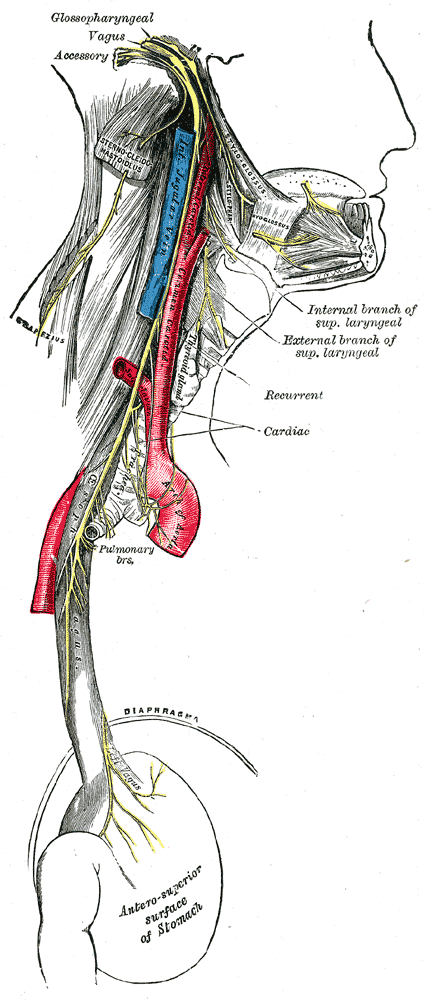
Anatomy
Cranial Nerve Lesions
Which of the following nerves is the efferent pathway of the gag reflex:
Answer:
The vagus nerve is the efferent pathway of the gag reflex. The glossopharyngeal nerve is the afferent pathway of the gag reflex.Cranial Nerve X: Vagus Nerve
Anatomy / Cranial Nerve Lesions / Head and Neck / Neck
Last Updated: 10th August 2019
The vagus nerve (CN X) is a mixed motor and sensory nerve which mediates phonation, swallowing, elevation of the palate and taste, and innervates viscera of the neck, thorax and abdomen.
Table: Overview of the Vagus Nerve
| Cranial Nerve | Vagus Nerve (CN X) |
|---|---|
| Key anatomy | Originates in medulla, exits skull via jugular foramen, descends in neck within carotid sheath |
| Sensory function | Larynx, laryngopharynx, external ear, external acoustic meatus, dura mater of posterior cranial fossa, thoracic and abdominal viscera, taste around epiglottis and pharynx |
| Motor function | Muscles of soft palate (except tensor veli palatini) , muscles of pharynx (except stylopharyngeus), muscles of larynx, palatoglossus muscle of tongue, visceral efferent fibres to viscera of neck, thorax and abdomen, efferent pathway of gag reflex |
| Assessment | Ask patient to say ‘ahhh’ to look for uvular deviation, gag reflex, swallowing, speech |
| Clinical effects of injury | Dysarthria, dysphonia, dysphagia, stridor, loss of gag reflex, uvular deviation away from affected side |
| Causes of injury | Trauma, neck surgery, tumours, aneurysms, jugular foramen syndrome |
Anatomical Course
The vagus nerve originates in the medulla, exits the skull via the jugular foramen (with CN IX and XI), then descends in the carotid sheath to innervate the neck, chest and abdomen.

Vagus Nerve. (Image by Henry Vandyke Carter [Public domain], via Wikimedia Commons)
Function
The vagus nerve carries:
- General sensory afferent fibres from the larynx, laryngopharynx, deeper parts of the auricle, part of the external acoustic meatus and the dura mater of the posterior cranial fossa
- General visceral afferent fibres from the aortic body chemoreceptors and aortic arch baroreceptors, and the pharynx, larynx, oesophagus, trachea, heart and lungs and abdominal viscera as far as the mid-transverse colon
- Special afferent fibres for taste around the epiglottis and pharynx
- Parasympathetic fibres to the pharynx, larynx, thoracic viscera, and abdominal viscera as far as the mid-transverse colon
- Motor fibres to the palatoglossus muscle of the tongue, the muscles of the soft palate (except for the tensor veli palatini), the muscles of the pharynx (except the stylopharyngeus), the muscles of the larynx and the striated muscle of the upper oesophagus
- General visceral efferent fibres to the viscera of the neck and the thoracic and abdominal cavities as far as the mid-transverse colon
Assessment
The vagus nerve can be assessed together with the glossopharyngeal nerve (CN IX) by:
- Asking the patient to cough
- Asking the patient to open the mouth wide and say 'ah' while visualising the palate and posterior pharyngeal wall (the soft palate should move upwards centrally)
- Testing the gag reflex
Likely Causes of Disease or Injury
The vagus nerve may be damaged by:
- Trauma or neck surgery
- Lateral medullary syndrome
- Aortic aneurysms
- Tumours (mediastinal or lung carcinoma)
- Jugular foramen syndrome
Common Clinical Effects
Vagus nerve palsy results in:
- Ipsilateral palatal weakness with nasal speech and nasal regurgitation of food (the soft palate and uvula will move asymmetrically when the patient says 'ahh' - away from the affected side)
- Ipsilateral pharyngeal weakness with dysphagia
- Ipsilateral laryngeal weakness with hoarseness, aphonia, and stridor
- Loss of gag reflex (efferent pathway)
Report A Problem
Is there something wrong with this question? Let us know and we’ll fix it as soon as possible.
Loading Form...
- Biochemistry
- Blood Gases
- Haematology
| Biochemistry | Normal Value |
|---|---|
| Sodium | 135 – 145 mmol/l |
| Potassium | 3.0 – 4.5 mmol/l |
| Urea | 2.5 – 7.5 mmol/l |
| Glucose | 3.5 – 5.0 mmol/l |
| Creatinine | 35 – 135 μmol/l |
| Alanine Aminotransferase (ALT) | 5 – 35 U/l |
| Gamma-glutamyl Transferase (GGT) | < 65 U/l |
| Alkaline Phosphatase (ALP) | 30 – 135 U/l |
| Aspartate Aminotransferase (AST) | < 40 U/l |
| Total Protein | 60 – 80 g/l |
| Albumin | 35 – 50 g/l |
| Globulin | 2.4 – 3.5 g/dl |
| Amylase | < 70 U/l |
| Total Bilirubin | 3 – 17 μmol/l |
| Calcium | 2.1 – 2.5 mmol/l |
| Chloride | 95 – 105 mmol/l |
| Phosphate | 0.8 – 1.4 mmol/l |
| Haematology | Normal Value |
|---|---|
| Haemoglobin | 11.5 – 16.6 g/dl |
| White Blood Cells | 4.0 – 11.0 x 109/l |
| Platelets | 150 – 450 x 109/l |
| MCV | 80 – 96 fl |
| MCHC | 32 – 36 g/dl |
| Neutrophils | 2.0 – 7.5 x 109/l |
| Lymphocytes | 1.5 – 4.0 x 109/l |
| Monocytes | 0.3 – 1.0 x 109/l |
| Eosinophils | 0.1 – 0.5 x 109/l |
| Basophils | < 0.2 x 109/l |
| Reticulocytes | < 2% |
| Haematocrit | 0.35 – 0.49 |
| Red Cell Distribution Width | 11 – 15% |
| Blood Gases | Normal Value |
|---|---|
| pH | 7.35 – 7.45 |
| pO2 | 11 – 14 kPa |
| pCO2 | 4.5 – 6.0 kPa |
| Base Excess | -2 – +2 mmol/l |
| Bicarbonate | 24 – 30 mmol/l |
| Lactate | < 2 mmol/l |

